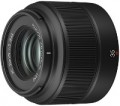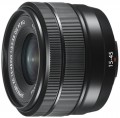Lens type
General lens type. Note that this parameter is largely determined by the equivalent (not actual) focal length, but in the characteristics of optics, the actual value is most often indicated; see "Focal length" for more on this.
The type is not indicated for any optics, but only for models that have a pronounced specialization and clearly fit into a certain category. In addition to them, there are so-called
universal lenses — see below about them. And specialized models can be of the following types:
—
Fix. This category on our website includes almost all lenses that do not provide the ability to change the focal length. These can be wide-angle models, and optics with a long focal length, providing a high degree of magnification, and models with average values; the only exception is the ultra-wide-angle fisheye, which is a separate type (see below). Due to the simpler design, fixes are usually cheaper and more reliable than similar zoom models. Their main disadvantage is the actual constant focal length. Because of this, when working with fixes, you have to have your own lens for each type of shooting, and zooming in / out of the image is carried out solely by moving the camera closer / farther relative to the object being filmed (in professional jargon — “zoom with your feet”).
—
Wide angle. Zoom lenses, the minimum value of which is up to 18 m
...m inclusive, the maximum is up to 40 mm inclusive (both are in 35 mm equivalent). This provides a wide viewing angle with virtually no visible distortion (unlike ultra-wide-angle models, see below). "Wide angles" are often used for shooting landscapes, large objects, etc.; also, such a lens can be useful in tight conditions, where you need to capture the widest possible scene (for example, a large group of people), and the situation does not allow you to move far away.
— Ultra wide angle. Also, this type of lens is called fisheye, or "fisheye". Their equivalent focal length is up to 17 mm inclusive, and viewing angles can reach 180° and even more, which allows capturing a very large area of the surrounding space in one picture (for example, the sky around the entire circumference of the horizon). Such lenses have noticeable distortion in the resulting image: the centre of the frame looks closer than the edges, and straight lines that do not pass through the centre of the frame become crooked. Because of this, fisheye optics got their name: the view through it is similar to how a fish sees the ground from under the water. Most often, fisheyes have a fixed focal length, but there are also zoom lenses. Such lenses are used, in particular, to create panoramas, shooting in confined spaces, as well as to provide artistic effects.
— Tele. Lenses with a long focal length and, accordingly, a high degree of magnification, designed primarily for shooting at long distances. If we talk about specific numbers, then in our catalog telephoto lenses include models with a variable focal length, in which the lower limit of the focal length is at least 50 mm, and the upper limit is at least 200 mm. Such optics can be convenient, in particular, when shooting nature, sports competitions and mass events.
In addition to those described above, many lenses are produced that meet the criteria for several types at once or do not fit into any of them. Examples include, in particular, an intermediate option between wide-angle and telephoto lenses with a focal length of 24 to 55 mm, or a model with an extensive adjustment range like 28 – 200 mm, covering both of these types. Such lenses without specialization are called universal. In general, their scope is quite wide, and most of the optics supplied in the kit (kit) with SLR cameras belong to the mentioned “intermediate option”. However in terms of image quality, universal models are often inferior to specialized optics with a similar price; on the other hand, a set of several specialized lenses often costs more than a high-end "station wagon" with the same capabilities.Aperture value
Lens aperture is a characteristic that determines how much the lens attenuates the light flux passing through it. It depends on two main characteristics — the diameter of the active aperture of the lens and the focal length — and in the classical form is written as the ratio of the first to the second, while the diameter of the active aperture is taken as a unit: for example,
1 / 2.8. Often, when recording the characteristics of a lens, the unit is generally omitted, such a record looks, for example, like this:
f / 1.8 or
f/2.0. At the same time, the larger the number in the denominator, the smaller the aperture value:
f / 4.0 lenses will produce a darker image than
models with f / 1.4 aperture.
Zoom lenses usually have different aperture values for different focal lengths. In this case, the characteristics indicate two aperture values, for the minimum and maximum focal lengths, respectively, for example: f / 4.5-5.6
The larger the aperture of the lens, the shorter shutter speeds it allows you to use when shooting. This is especially important when shooting fast-moving subjects, shooting in low light, etc. And if necessary, the light stream transmitted by the lens can be weakened using a diaphragm (see below).
Another point that directly depends on this indicator is the depth o
...f field (the depth of space that is in focus when shooting). The higher the aperture, the smaller the depth of field, and vice versa. Therefore, shooting with artistic background blur (bokeh) requires high-aperture optics, and for a large depth of field, you have to cover the aperture.Min. diaphragm
Aperture is a design of several blades-curtains, which allows, if necessary, to reduce the diameter of the active aperture of the lens, actually reducing its aperture (for more details, see "Aperture"). In addition to reducing the light output (which can be relevant, for example, in bright sunlight), closing the aperture has another effect — it increases the depth of field. In other words, “in focus” is a larger volume of space than with an open aperture.
The values on the aperture scale are usually selected from a standard range. The numbers in it actually indicate what aperture the lens will have when the aperture is closed to a given value: for example, an aperture value of 5.6 will correspond to f / 5.6 aperture. The larger the number indicating the minimum aperture value, the more options the photographer has and, accordingly, the possibilities for setting the shooting mode (ceteris paribus).
Minimum focus distance
Minimum focus distance (m) - the smallest distance from which you can focus on an object and take a photo. Usually it ranges from 20 cm for wide-angle lenses to several metres for telephoto. In the macro mode of the camera or with the help of macro lenses, this distance can be less than 1 centimeter.
Maximum zoom
The degree of magnification of the object being shot when using a
lens for macro shooting (that is, shooting small objects at the maximum possible approximation, when the distance to the subject is measured in millimetres). The degree of magnification in this case means the ratio of the size of the image of the object obtained on the matrix of the camera to the actual size of the object being shot. For example, with an object size of 15 mm and a magnification factor of 0.3, the image of this object on the matrix will have a size of 15x0.3=4.5 mm. With the same matrix size, the larger the magnification factor, the larger the image size of the object on the matrix, the more pixels fall on this object, respectively, the clearer the resulting image, the more details it can convey and the better the lens is suitable for macro photography. It is believed that in order to obtain macro shots of relatively acceptable quality, the magnification factor should be at least 0.25 – 0.3.
Image stabilization
The presence in the lens of its own
image stabilization system. Such a system includes gyroscopes and movable lenses that compensate for small tremors of the lens and prevent the appearance of “shake”. Stabilization is especially relevant when shooting handheld, especially at slow shutter speeds and/or at long distances with high magnification: it is in such conditions that “shake” affects the quality of the image the most. At the same time, it should be taken into account that the presence of a stabilizer significantly affects the weight, dimensions and, above all, the price of optics; at the same time, some modern cameras have their own stabilization systems (due to matrix shift). Therefore, it makes sense to choose a lens with this function in the case when maximum protection against “shake” is of fundamental importance.
Design (elements/groups)
The number of elements (in fact, the number of lenses) included in the design of the lens, as well as the number of groups in which these elements are combined. Usually, the more elements provided in the design, the better the lens handles with distortions (aberrations) when light passes through it. On the other hand, numerous lenses increases the dimensions and weight of the optics, reduces light transmission (for more details, see "Aperture") and also puts forward increased requirements for the quality of processing, which affects the cost of the lens.
Number of diaphragm blades
The number of blades provided in the design of the diaphragm (for details, see "Minimum aperture"). In fact, this parameter is important when shooting scenes with pronounced bokeh (blurred background) and a small depth of field: the more petals the aperture has, the smoother the glare from out-of-focus objects will turn out, while with a small number of petals they can look like polygons. The number of aperture blades has almost no effect on other shooting parameters. Modern lenses have an average of 7-9 petals; the smoothing provided by them in most cases is considered quite sufficient.
Filter diameter
Thread diameter for installation on the filter lens. Light filters are devices for changing the parameters of the light flux entering the lens. They can be used for highlighting individual colours, coloring the entire image in one colour, darkening the image, correcting colour temperature and light balance, shooting in the infrared range, etc. Also, a light filter can play the role of protection against pollution. For successful installation on the lens, the diameter of the filter must match the diameter of the filter specified for this model of optics.

